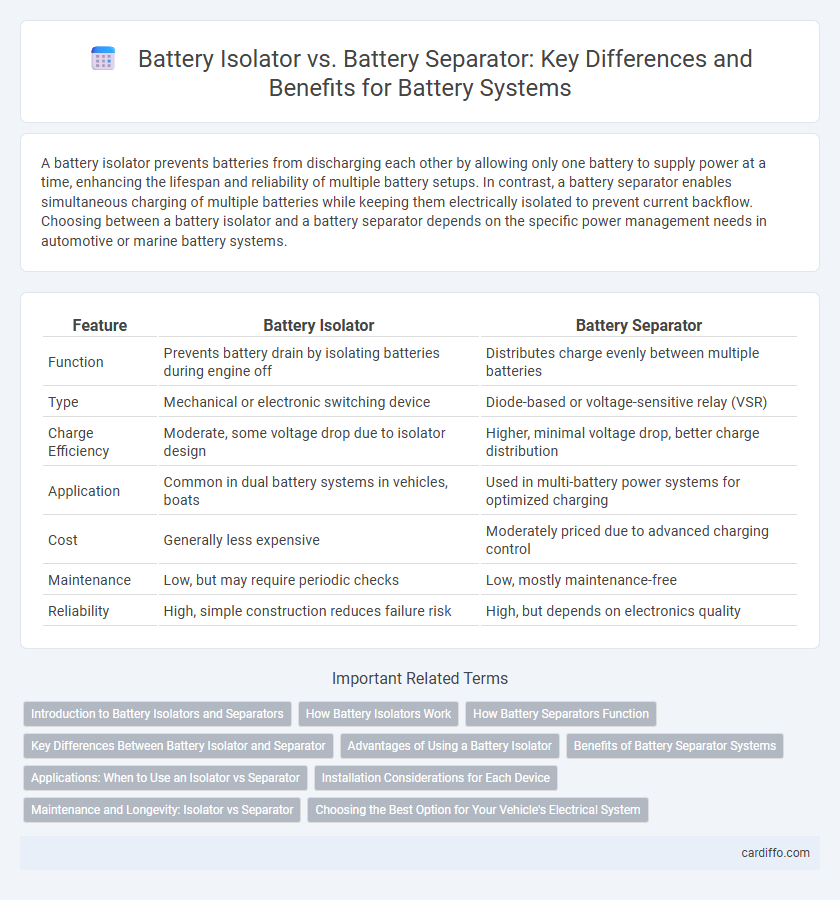A battery isolator prevents batteries from discharging each other by allowing only one battery to supply power at a time, enhancing the lifespan and reliability of multiple battery setups. In contrast, a battery separator enables simultaneous charging of multiple batteries while keeping them electrically isolated to prevent current backflow. Choosing between a battery isolator and a battery separator depends on the specific power management needs in automotive or marine battery systems.
Table of Comparison
| Feature | Battery Isolator | Battery Separator |
|---|---|---|
| Function | Prevents battery drain by isolating batteries during engine off | Distributes charge evenly between multiple batteries |
| Type | Mechanical or electronic switching device | Diode-based or voltage-sensitive relay (VSR) |
| Charge Efficiency | Moderate, some voltage drop due to isolator design | Higher, minimal voltage drop, better charge distribution |
| Application | Common in dual battery systems in vehicles, boats | Used in multi-battery power systems for optimized charging |
| Cost | Generally less expensive | Moderately priced due to advanced charging control |
| Maintenance | Low, but may require periodic checks | Low, mostly maintenance-free |
| Reliability | High, simple construction reduces failure risk | High, but depends on electronics quality |
Introduction to Battery Isolators and Separators
Battery isolators and battery separators are essential components in dual-battery systems, designed to manage power distribution and prevent battery drainage. A battery isolator allows multiple batteries to be charged simultaneously from a single alternator while preventing the batteries from discharging into each other. Battery separators, often used in marine and RV applications, employ solid-state technology to separate electrical circuits, ensuring each battery operates independently without interference.
How Battery Isolators Work
Battery isolators use diodes or solenoids to manage the flow of electrical current between multiple batteries, ensuring that each battery charges independently while preventing discharge from one battery to another. By automatically directing the alternator's charging power to the appropriate battery, isolators maintain optimal voltage levels and extend battery life. This mechanism safeguards the starting battery from being drained by auxiliary loads, enhancing the reliability of vehicle electrical systems.
How Battery Separators Function
Battery separators function as critical insulating barriers placed between the anode and cathode within a battery cell, preventing direct electrical contact while allowing ionic flow. Made from microporous materials like polyethylene or polypropylene, these separators enable electrolyte permeability to facilitate ion transport essential for charge and discharge cycles. Their role ensures battery safety by reducing the risk of short circuits and enhancing overall battery longevity and efficiency.
Key Differences Between Battery Isolator and Separator
Battery isolators and battery separators both manage power distribution between multiple batteries but function differently; isolators primarily prevent batteries from discharging into each other while allowing simultaneous charging. Separators, often used in lead-acid batteries, physically separate positive and negative plates to prevent short circuits and ensure proper ionic flow within the battery cell. Understanding these distinctions is crucial for optimizing battery management systems in vehicles and renewable energy setups.
Advantages of Using a Battery Isolator
A battery isolator offers the advantage of preventing the discharge of one battery by another, ensuring independent operation and extending battery life in dual-battery systems. It provides efficient electrical separation while allowing simultaneous charging from a single alternator, which optimizes power management in vehicles and marine applications. Battery isolators also protect sensitive electronics by preventing backflow of current and reducing the risk of deep discharge or battery failure.
Benefits of Battery Separator Systems
Battery separator systems enhance the longevity and safety of multi-battery setups by preventing electrical current flow between batteries while allowing simultaneous charging. These systems reduce the risk of over-discharging individual batteries and improve the overall efficiency of power distribution in automotive and marine applications. By maintaining isolated circuits, battery separators ensure optimal battery performance and reliability under various load conditions.
Applications: When to Use an Isolator vs Separator
Battery isolators are ideal for automotive and marine applications requiring independent battery charging to prevent drainage between multiple batteries. Battery separators suit renewable energy systems and backup power setups where parallel battery operation and balanced charge distribution are critical. Choosing an isolator is best when isolating circuits is needed, while separators excel in maintaining battery bank integrity during simultaneous charging and discharging.
Installation Considerations for Each Device
Battery isolators require careful wiring to ensure proper current flow and prevent backfeed, typically installed in series with multiple batteries to allow simultaneous charging without electrical interference. Battery separators, often simpler in design, must be installed in parallel with batteries to physically and electrically separate circuits, minimizing voltage drops and ensuring consistent power distribution. Proper installation of either device depends on the application, with isolators favored in dual-battery systems for vehicles and separators preferred for managing individual cell protection or maintaining battery health.
Maintenance and Longevity: Isolator vs Separator
Battery isolators require minimal maintenance due to their simple diode or solenoid design, ensuring long-term reliability with fewer failure points. Battery separators, while offering smoother voltage regulation and improved charging efficiency, may need periodic checks to prevent wear and degradation in separating elements. Choosing a battery isolator generally enhances longevity by reducing electrical stress, whereas separators demand more attention to sustain optimal performance over time.
Choosing the Best Option for Your Vehicle's Electrical System
Battery isolators and battery separators both protect your vehicle's electrical system by preventing battery drain but operate differently; isolators use diodes or relays to fully isolate batteries, while separators allow controlled charging between batteries. Choosing the best option depends on your vehicle's setup, with isolators ideal for dual-battery systems requiring complete separation, and separators suited for systems needing balanced voltage distribution. Evaluating factors like load capacity, voltage compatibility, and system complexity ensures optimal performance and extended battery life.
Battery Isolator vs Battery Separator Infographic

 cardiffo.com
cardiffo.com